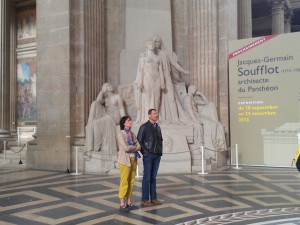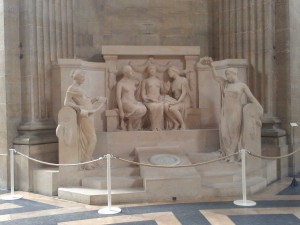On Monday we visited the Pantheon where important people such as Jean Moulin, Jean-Jacques Rousseau, and Victor Hugo are buried.
The building itself was begun under the reign of King Louis XV as a dedication to Saint Genevieve. Construction began in 1758. It was not completed during his reign, however, and when the French Revolution occurred the original plans were modified.
It is a strange mix of the ideals of the French Republic and religion. On the walls are beautiful paintings depicting the story of Saint Genevieve, who is the patron saint of Paris. Her story is she calmed the people of Paris while the approaching army of the Huns threatened them. She organized city prayers, and the army turned back and never set foot in Paris. She was believed to have created the miracle, and is forever recognized as the patron saint of Paris.

Along the rear walls is a memorial to the writers that were killed during WWII. The writers during this time were politically involved, and often were persecuted if they did not abide by the German censorship during the occupation. The memorial lists the names of those writers, and recognizes their sacrifices.
Underneath the building are the crypts. The crypts are generally simple with the exception of a few famous figures, such as Voltaire’s statue. Jean Moulin is also buried here, and he was an important figure for the French Resistance. He helped to unify France during WWII and worked with Charles de Gaulle during the Resistance.
He started his political career in 1937 as the youngest prefect, but during the German Occupation he refused to cooperate with the German government. He was tortured by Gestapo, one of the highest ranking officers in the Nazi regime, but he never succumbed. He was later removed from his position by the Vichy government and tortured again for his involvement in the Resistance.
While in prison he attempted to commit suicide by using a piece of broken glass to slit his throat, but the failed attempt left a scar that he would hide with a scarf. The image of Jean Moulin with a scarf is the most popular and common image throughout Paris. In June 1943 it was officially recorded that he died on the train to a concentration camp, but some believe he was simply beaten to death by the Gestapo. In 1964 his ashes were moved to a crypt in the Pantheon.
This is a great place to visit since it does not receive as many tourists as other areas, although the map for the crypt is very confusing!
